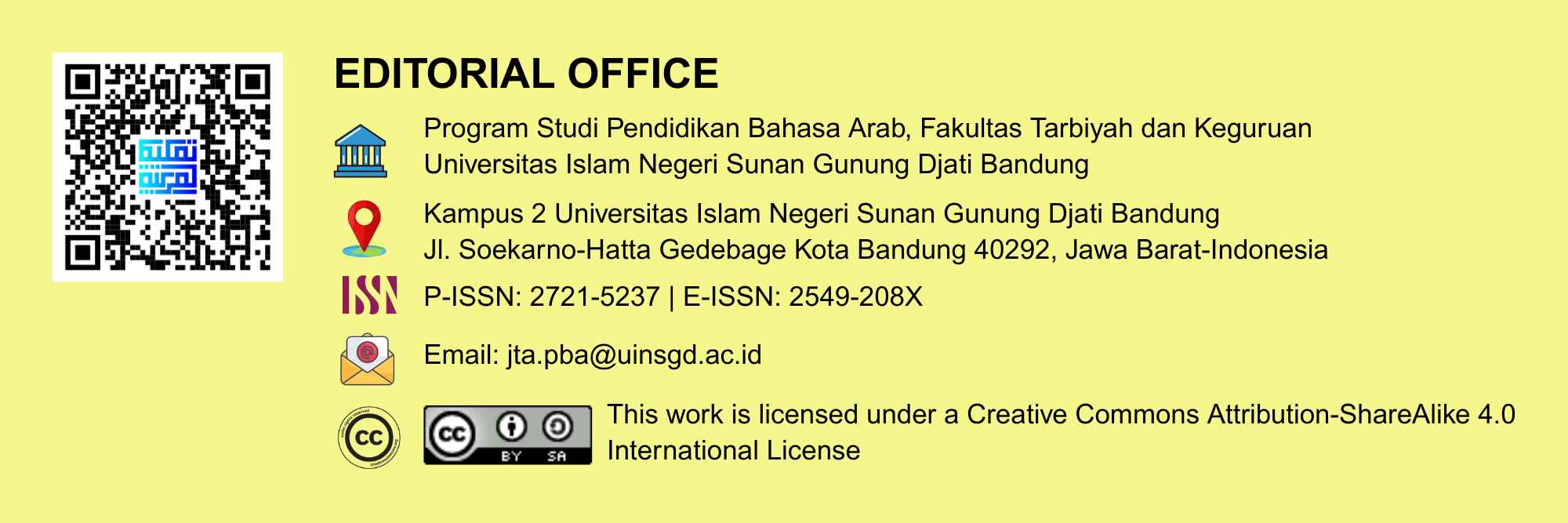Model Materi Ajar KitÄbah Muqayyadah Berbasis CEFR dan Terintegrasi Keterampilan Abad Ke-21
DOI:
https://doi.org/10.15575/jpba.v6i1.17347Abstract
This study aims to develop a CEFR-based model of teaching materials for Kitâbah Muqayyadah and integrated 21st century skills. This research was conducted with a development research approach that started with situation analysis, needs analysis, and the development of learning model design concepts. Based on the results of the situation analysis and needs analysis, the development of a model of Kitâbah Muqayyadah teaching materials based on CEFR and integrated 21st century skills are very much needed. The concept of developing a teaching material model is based on a literature review that produces eight 21st century skills. Meanwhile, the ordering model of the Kitâbah Muqayyadah teaching material, which is a writing skill for beginners, is arranged in eight sequences of material starting from the level of compiling isolated sentences to composing image-assisted discourse. In combining or integrating eight 21st century skills in eight sequences of material, teachers can adapt the learning methods to be applied while considering the objectives of each meeting.
References
Abdel-Malek, M. (2020). Empowering Arabic learners to make meaning: A genre-based approach. System, 94, 102329. https://doi.org/10.1016/j.system.2020.102329
Ahn, H. (2012). Teaching writing skills based on a genre approach to L2 Primary school students: An action research. English Language Teaching, 5(2), 2–16. https://doi.org/10.5539/elt.v5n2p2
Alawiyah, N . Ahmad, lalah. Nawawi, R., & . Islam, M. (2016). Pengembangan Bahan Ajar Maharah Al-Kitabah Berbasis Pendidikan Karakter bagi Mahasiswa Program Studi Pendidikan Bahasa Arab STAI At-Tanwir Bojonegoro. Al-Bayan, 9(2), 68. http://ejournal.radenintan.ac.id/index.php/albayan/article/view/1241/1082
Bakry, M. S., & Alsamadani, H. A. (2015). Improving the Persuasive Essay Writing of Students of Arabic as a Foreign Language (AFL): Effects of Self-Regulated Strategy Development. Procedia - Social and Behavioral Sciences, 182, 89–97. https://doi.org/10.1016/j.sbspro.2015.04.742
Borg, W. R. ., & Gall, M. D. (2003). Educational Research, An Introduction (Fourth Edi). Longman Inc.
Branch, R. M. (2009). Instructional Design: The ADDIE Approach. In Encyclopedia of Creativity, Invention, Innovation and Entrepreneurship. Springer. https://doi.org/10.1007/978-3-319-15347-6_300893
Calkin, A. B. (2016). Writing on writing. International Journal of Educational Research, 87(April 2016), 127–137. https://doi.org/10.1016/j.ijer.2017.05.002
Erdogan, V. (2019). Integrating 4C Skills of 21st Century into 4 Language Skills in EFL Classes Vacide Erdoğan. International Journal of Education and Research, 7(11), 113–124. www.ijern.com
Golparvar, S. E., & Khafi, A. (2021). The role of L2 writing self-efficacy in integrated writing strategy use and performance. Assessing Writing, 47(November 2020), 100504. https://doi.org/10.1016/j.asw.2020.100504
Hyland Ken. (2007). Second Language Writing (4t ed.). Cambridge University Press.
Marzec-Stawiarska, M. (2016). The influence of summary writing on the development of reading skills in a foreign language. System, 59, 90–99. https://doi.org/10.1016/j.system.2016.04.006
Partnership for 21st Century. (2007). Framework for 21st Century Learning. www.P21.org.
Pastor, A. J., & Guillot, C. P. (2015). Beyond the CEFR: Towards Standardization of Language Competence Recognition in Europe. Procedia - Social and Behavioral Sciences, 178(November 2014), 146–150. https://doi.org/10.1016/j.sbspro.2015.03.171
Roscoe, R., Wilson, J., Patchan, M., Chen, D., & Johnson, A. (2020). Modeling student evaluations of writing and authors as a function of writing errors. Journal of Language and Education, 6(2), 147–164. https://doi.org/10.17323/JLE.2020.10316
Setiadi, Samsi. (2017). Peningkatan keterampilan kitabah arabiyah mahasiswa melalui metode tutor sebaya. Al-Bayan, 9(1), 1–9.
Setiadi, Syamsi, & Salsabila, N. K. (2021). Model Pembelajaran Kitabah Arabiyah Terintegrasi Keterampilan Abad ke-21. PINBA XIII 2021, 253–263.
Talkauthor, T., Bleakney, J., Pittock, S. P., Miller, B., McCardle, P., Connelly, V., Small, J. D., Mavrogenes, N. A., Bezruczko, N., Mavrogenes, N. A., Bezruczko, N., Editor, B., McCardle, P., Connelly, V., Dockrell, J., Connelly, V., Walter, K., Critten, S., Daiute, C., … Karlsson, G. (2019). Writing Development in Struggling Learners. Writing Development in Struggling Learners, 37(2), 127–160. https://doi.org/10.1163/9789004346369
Trilling, B., & Fadel, C. (2009). 21st Century Skills: Learning for Life in Our Times. Jossey-Bass/John Wiley & Sons, Inc.
Wagner, D. (2013). Literacy and UNESCO: Conceptual and Historical Perspectives. New Directions for Adult and Continuing Education, 2013(138), 19–27. https://doi.org/10.1002/ace.20050
Westhoff, G., & Netherl, T. (2019). Challenges and Opportunities of the CEFR for Reimagining Foreign Language Pedagogy Author ( s ): Gerard Westhoff Source : The Modern Language Journal , Vol . 91 , No . 4 ( Winter , 2007 ), pp . 676-679 Published by : Wiley on behalf of the National Federa. 91(4), 676–679.
Downloads
Published
How to Cite
Issue
Section
Citation Check
License
Authors who publish in Ta'lim al-'Arabiyyah: Jurnal Pendidikan Bahasa Arab dan Kebahasaaraban agree to the following terms:
- Authors retain copyright and grant the journal right of first publication with the work simultaneously licensed under a Creative Commons Attribution-ShareAlike 4.0 International (CC BY-SA 4.0) License that allows others to share the work with an acknowledgment of the work's authorship and initial publication in this journal.
- Authors are able to enter into separate, additional contractual arrangements for the non-exclusive distribution of the journal's published version of the work (e.g., post it to an institutional repository or publish it in a book), with an acknowledgment of its initial publication in this journal.
- Authors are permitted and encouraged to post their work online (e.g., in institutional repositories or on their website) prior to and during the submission process, as it can lead to productive exchanges, as well as earlier and greater citation of published work (See The Effect of Open Access).
![]()
Ta'lim al-'Arabiyyah: Jurnal Pendidikan Bahasa Arab dan Kebahasaaraban is licensed under a Creative Commons Attribution-ShareAlike 4.0 International License.
Based on a work at https://journal.uinsgd.ac.id/index.php/Talim








